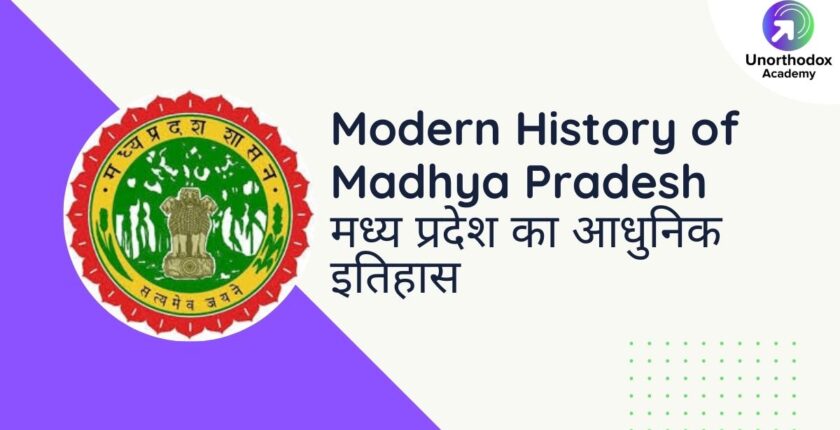Notes on Modern History of Madhya Pradesh
- May 7, 2022
- Posted by: Admin
- Category: Madhya Pradesh Specific Notes MP Patwari Exam MPPSC State PSC Exams

The modern history period was an important period in Madhya Pradesh History. It has been seen that many questions have been asked in MPPSC and other state govt exams from the “Modern History of Madhya Pradesh”. MPPSC candidates must not miss it at any cost!!
Modern History of Madhya Pradesh
A new chapter of Madhya Pradesh started with the rise of Mughals and the advent of the East India Company in India.
Mughals and Britishers rise
- Peshwa Bajirao started his journey towards northern India.
- In Vindhya Pradesh, Champat Rai retaliated against the exploiting policies of Aurangzeb.
- Appa Saheb Bhonsle came to the throne of Nagpur in February 1817. He signed a treaty of subsidiary alliance with East India Company.
- The districts of Sagar and Damoh were given to the Peshwa of Pune by the Bundela King Chhatrashal.
- After the deposition of Peshwas by Lord Hastings 20 districts of Mandela, Betul, Seoni and Narmada Valley were added to the British in 1817.
The emergence of feelings of revolt
- In 1842, there was dissatisfaction in these areas against the British tyranny.
- This dissatisfaction took the shape of revolt and under different leaderships upsurge started.
- Jawahar Singh Bundela of Chandrapur and Madhukar Saha of Narhat took the leadership.
- Several other chiefs of smaller regions like Gond King Dilshan Shah of Madanpur, King Hirde Shah of Heerapur joined them.
Annexation of important places by Britishers
- In December 1853, Raghuji III, the King of Nagpur died and his state was annexed to British dominion, followed by the annexation of Satara, Jhansi and several other states.
- All these rulers stood together against the unfair practices of British rule an upsurge took the form of revolt and the first agitation took place in 1857.
Revolt of 1857
- The Revolt of 1857 was the first agitation with an all-Indian character.
- It affected a vast region from Meerut to Kolhapur involving all Indian society sections and religions.
- Only after a month of the spark of revolt in Meerut and Delhi, it spread to far-flung areas of India and swept Sagar-Narmada territory and Nagpur.
- Mardan Singh of Banpur and King Bakthbali of Shahagarh took leading parts in the revolt.
- By August 1857 the entire area of the north of Narmada except Jabalpur and Mandla went in the possession of freedom forces.
- Several independent rulers whose states were annexed to British territory fought bravely in the revolt.
- The Rani of Ramgarh, the Rani of Jhansi, Tantia Tope and Nana Sahib were a few of them.
- Tantia Tope continued his Guerilla warfare against the British after the death of Rani of Jhansi in June 1857. Unfortunately, he fell prey to treason and in April 1859 he was hanged to death.
Indian Freedom Struggle
- The sparks of the revolt of 1857 ultimately culminated in the form of a fire of freedom struggle across the nation.
- Madhya Pradesh was also one of the many states which were burning in that fire.
- The first outbreak of the people of Madhya Pradesh took place in June 1857, when the bungalows of British officials were set on fire in Neemuch.
- Soon, the Indian soldiers at Murar (Gwalior) Cantt rebelled and destroyed all the communication channels.
Jhanda Satyagraha
In 1923, at Jabalpur when the police commissioner insulted our national flag, the national flag was hoisted across the state and Sarojini Naidu and Maulana Azad hoisted the flag at the town hall of Jabalpur. The flag or Jhanda Satyagrah occurred in Nagpur and Jabalpur for several months in 1923.
Jungle Satyagraha
Jungle Satyagraha of 1930 in Jabalpur saw the participation of prominent leaders like Seth Govind Das, Makhanlal Chaturvedi, Pandit Ravi Shankar Shukla, Pandit Dwarika Prasad Mishra and Vishnu Dayal Bhargava. The Congressmen spread the Satyagraha from village to village and also among the aboriginal tribes of the jungles.
Charan Paduka Massacre
The Jallianwala Bagh massacre of Madhya Pradesh, where police opened fire on peaceful meetings of freedom fighters at Chattarpur and killed many innocent persons. On 14th January 1931 at a place called Charan Paduka, 50 km from Chattarpur town, a large meeting was held to protest against the princely rule. British forces dispersed the meeting and killed a number of people.
Individual Satyagraha
Gandhiji launches the nationwide individual Satyagraha at Jabalpur and Shri Vinoba Bhave became the first Individual Satyagrahi.
Some Sultanates of that time
Gwalior Sultanate
- The Indian kingdom of Gwalior was ruled by the Scindia dynasty. Scindia is a Maratha clan in India. The state got its name from the old town of Gwalior and was founded in the early 18 century by Ranoji Scindia as a part of the Maratha confederacy. Under Mahadji Scindia (1768 – 1794) Gwalior state became a leading power in northern India. The anglo Maratha brought the Gwalior state under the British dominion.
- In 1936, it was separated from the central Indian agency and kept directly under the government Governor-General of India. After Indian independence in 1947 is kill the rulers were added to the government of India and thus Gwalior became part of the new Indian state of Madhya Pradesh
Bhopal Sultanate
- Bhopal was an independent state of 18th century India.
- It was a princely state of India from 1818 to 1947 and an Indian state from 1949 to 1956.
- Its capital was Bhopal city after independence.
- Bhopal was the last State to us to sign the instrument of accession according to the states reorganization act of 1957 the Bhopal state was integrated into Madhya Pradesh.
- As a result of the Anglo – Bhopal Treaty between the East India Company and Nawab Nazar Mohammad Nawab of Bhopal, Bhopal became a princely state in British India in March 1818.
Rewa Sultanate
- Rewa became a princely state in 1812 and remained until the independence of India in 1947.
- Rewa’s rulers were the Solanki or Chalukya clan’s Rajput of Vaghela branch.
Madhya Pradesh: After Independence
- In 1950, Madhya Bharat was created from former British Central Provinces. The new states of Madhya Pradesh, Vindhya Pradesh and Bhopal were formed from central Indian agencies.
- In 1956, the states of Madhya Bharat, Vindhya Pradesh and Bhopal were merged into Madhya Pradesh. Bhopal became the capital.
- In November 2000, the southeastern portion of the state was split off after the Madhya Pradesh Reorganization Act to form Chattisgarh’s (26th state) new state with the capital Raipur.
MPPSC Free Study Material (English/Hindi)
Download NCERT in Hindi – https://unorthodoxacademy.com/ncert-pdf-in-hindi/
Download NCERT in English – https://unorthodoxacademy.com/ncert-pdf-in-english/
🤩Follow us for Free Study Material
YouTube 👉 https://bit.ly/36wAy17
Telegram👉 https://bit.ly/3sZTLzD
Facebook 👉 https://bit.ly/3sdKwN0
Daily Current Affairs Quiz for UPSC, MPSC , BPSC and UPPSC : Click here for Month Wise Quiz

